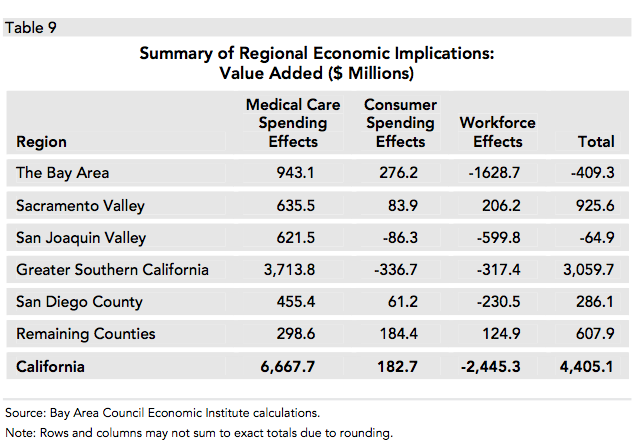1 The implications for state and local tax revenues of changes in spending patterns are also presented in the online technical appendix. As accumulated revenues are not uniform across products and services, changes in spending patterns will have indirect effects on state and local revenues. These changes will be compared to levels that would be expected in the absence of the ACA.
2 Len Nichols, Julie Barnes, Micah Weinberg and Sarah Axeen, “The Future of Colorado Health Care: An Economic Analysis of Health Care Reform and the Impact on Colorado’s Economy,” New America Foundation, 2010, http://www.coloradotrust.org/sites/default/files/EconomicReport-Full-FINAL.pdf
3 John F. Sheils and Randall Haught, “Without The Individual Mandate, The Affordable Care Act Would Still Cover 23 Million; Premiums Would Rise Less Than Predicted,” Health Affairs 30:11 (November 2011), 2177–2184.
4 Bowen Garrett and Matthew Buettgens, “Employer-Sponsored Insurance under Health Reform: Reports of Its Demise Are Premature,” Robert Wood Johnson Foundation, January 2011.
5 Institute of Medicine, Hidden Costs, Value Lost: Uninsurance in America, (Washington, D.C.: National Academies Press, 2003).
6 Gerald Kominski, Ken Jacobs, et., al., “Health Insurance Coverage in California under the Affordable Care Act,” (presentation to the California Health Benefit Exchange Board, March 2012); in order to be conservative in our analysis, we rely on their “baseline” rather than their “enhanced” take-up scenario.
7 Kominski and Jacobs, 2012.
8 Jack Hadley et al., “Covering the Uninsured in 2008: Key Facts about Current Costs, Sources of Payment, and Incremental Costs,” Kaiser Commission on Medicaid and the Uninsured, August 2008.
9 Hadley et al., 2008. Both figures are adjusted by 7.4% for inflation between 2008 and 2010; all figures in the report are in 2010 dollars since the analysis compares what the equilibrium state would have been in California had the ACA been fully implemented on the date when it was passed.
10 Kominski and Jacobs, 2012.
11 Shiels and Haught, 2011; see also Mitt Romney, “Mr. President, What’s the Rush,” USA Today, July 30, 2009, 7A.
12 Arindrajit Dube, “Productivity Impact of Health Care Reform in California,” Institute for Labor and Employment, University of California, Berkeley, August 2003.
13 Phillip Cryan, “Will a Pay-or-Play Policy for Healthcare Cause Job Losses?” Economic Policy Institute, June 2009.
14 Office of Management and Budget, Federal government receipts, FY 2012, item 138, table 17-1, available at http://www.whitehouse.gov/sites/default/files/omb/budget/fy2013/assets/receipts.pdf
15 Institute of Medicine, 2003; see also Sarah Axeen and Elizabeth Carpenter, “The Cost of Doing Nothing,” New America Foundation, November 2008. Both of these studies estimated the value of improved health directly, while our report adopted a more conventional economic approach which measures it indirectly through increased labor force participation.
16 Source: 2007 U.S. Economic Census, U.S. Department of the Census.
17 Although California is the largest producer of pharmaceutical products, the state ranks 8th in terms of production per capita.
18 Karen E. Dynan, Jonathan Skinner and Stephen P. Zeldes, 2004. “Do the Rich Save More?” Journal of Political Economy, University of Chicago Press, vol. 112(2), pages 397–444.
19 See technical appendix to this report which is available online (at https://www.bayareaeconomy.org/files/pdf/ACATechAppendix.pdf).
20 Congressional Budget Office, Letter to the Honorable Nancy Pelosi, March 20, 2010 (Washington, D.C.: CBO, 2010), http://www.cbo.gov/sites/default/files/cbofiles/ftpdocs/113xx/doc11379/amendreconprop.pdf
21 David M. Cutler, Karen Davis, and Kristof Stremikis, “The Impact of Health Reform on Health System Spending,” The Commonwealth Fund, May 2010.
22 Sean P. Keehan et al., “National Health Spending Projections Through 2020: Economic Recovery And Reform Drive Faster Spending Growth,” Health Affairs 30, no 8 (2011), 11.














